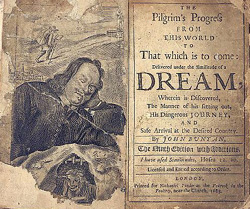Short Paper Page
“I saw a Man . . . a Book in his hand, and a great burden upon his back.”
Click on illustration for source.
Image from New York Public Library
Paper length: 750 words, double spaced, typed.
DUE DATE:Tuesday, 2/5
COMMENTARY: Along with the paper, please write a 1- page commentary on the writing of your paper. How did things go? What did you learn about yourself as a writer? The commentary is informal and will not be graded separately from the paper, but it is required. I read the commentary before reading the paper.
NB: Please read and take seriously "Paragraph and Sentence Pointers." Your success in this paper and in the longer paper depends on your learning strategies for revision--at the paragraph and sentence level as well as at the level of the whole paper. Look for revision opportunities before turning in your paper.
You will find below the "key" to my comments on drafts and papers. The key will guide your reading of my comments, but it also tells you how I read your paper.
PAPER TOPIC:
Establish a conceptual connection--and make an argument for it--between John Bunyan's The Pilgrim's Progress and the work of Augustine or the work of Descartes.
The success of your paper will depend on close reading, especially close reading of The Pilgrim's Progress. Paper length: 750 words (around 3 pages).The topic asks you to establish a "conceptual connection," which means that you don't have to worry about an historical connection. You don't need to know, for example, whether Bunyan read, and was deliberately following, the work of Augustine or Descartes. Bunyan probably hadn't read either. What you are looking for is common questions, shared or opposing metaphors, shared fears, etc. An informal way of asking the question is "How can you put Bunyan's TPP in the same picture with the work of Augustine or Descartes?"
- Sample thinking questions:
Is there any equivalent in Augustine or in Descartes to the "great burden upon his back" in The Pilgrim's Progress? What about dreaming? The dream vision gives TPP its form. Do dreams function significantly in Augustine or Descartes?
(We'll talk about thinking questions in class. They help you get started in your thinking but they don't supply the organization for your paper. Your own thinking supplies the organization for your paper.)
Since the paper is short, you will need to make every sentence count. Part of the work of the assignment is to say something important in a condensed and careful way.
PARAGRAPH AND SENTENCE POINTERS
Say what you mean: Put the most important meaning words in the most important grammatical positions. This move is one of your most important revision strategies. It will help you get rid of wordiness, initial delaying constructions, and clunky clauses; and it will encourage you to subordinate properly.*
Hook-ups: Sentences in a paragraph must "hook on to" preceding sentences. In each case, look for the stated or implied connector.
In hooking on to a previous sentence, each sentence does something to the previous one. You need to be able to say what each sentence is doing to the one before it. If your sentences have not met each other yet, they don't belong in the same paragraph.Develop your paragraphs: Most paragraphs in English start out in a certain direction and keep on going that way. Many start in one direction and then turn (with such words as "however" and "nevertheless"). There are two "rules" about turning: a) you can only turn once per paragraph; b) all sentences following the turn support that turn OR the original direction of the paragraph.* (One apparent exception is only apparent; I'll explain it in class.)
Test your paragraphs with the "paragraph test": cut the paragraph into sentences and see if another intelligent, attentive person can put the paragraph together again.
*These two ideas are from Frederick Crews's The Random House Handbook.
KEY: AJVS SYMBOLS FOR COMMENTING ON PAPERS
Check = nice, good, etc.
Check, check = very nice, good, etc.
_______ ________= Something is wrong with the connection
between circled or underlined elements.¶ = Paragraph.
¶ development, coherence, and unity. "Paragraph & Sentence Pointers" may help you with this.
Sp = spelling.
SS = sentence structure.
SVA = subject-verb agreement.
// ism = parallelism.
ref = reference not clear (for pronouns, etc.).
frag = sentence fragment.
P = punctuation problem.
ROS = run-on sentence.
CS = comma splice.
NI = not idiomatic.
Pass = passive voice used inappropriately.
Pred = predication. Something is wrong with the way you are putting together a subject and a verb.
wd ch = problem with word choice.
T = problem with shift in verb tense or with sequence of tense.
# = spacing. You need to add a space or spaces.
POV = point of view. You may want me to explain this problem while looking at your paper.
Rep = repetition.
Redundant = redundant.
Transition = Something amiss with transition between sentences or paragraphs.
Subordination = problem with subordination.
Logic = Problem with logic, e.g., your evidence doesn't match your claim; you have made an unacknowledged assumption or you have assumed agreement that doesn't exist; you have drawn an inference that doesn't follow from your observation or from your evidence.
Leap = Same as above.
Meaning ? = Even with effort, I find this sentence or phrase hard to understand.
Hm . . . = I'm not persuaded. Sounds doubtful to me.
This = Try not to usethe word "this" without a noun following it. Say "this point," "this idea," "this problem," etc., rather than "this," "this,","this."
GSS = Getting-started sentences; omit.
TOS = Too obvious to state.
TSINWVH = This sentence is not working very hard.
TSDNATKEO = These sentences do not appear to know each other. Please introduce them. And please see paragraph and sentence pointer on "hook-ups."
AMAT = Ask me about this [point].
CA = Clarify assertion. One frequent possibility: Put the most important meaning words in the most important grammatical positions.
See advice on sentences and paragraphs: "Say what you mean."Condense = Clarify assertions, subordinate appropriately, and aim for economy in expression. You often need to condense in order to see what needs to be done next.


